Ke Huang
Generalization and Risk Bounds for Recurrent Neural Networks
Nov 05, 2024Abstract:Recurrent Neural Networks (RNNs) have achieved great success in the prediction of sequential data. However, their theoretical studies are still lagging behind because of their complex interconnected structures. In this paper, we establish a new generalization error bound for vanilla RNNs, and provide a unified framework to calculate the Rademacher complexity that can be applied to a variety of loss functions. When the ramp loss is used, we show that our bound is tighter than the existing bounds based on the same assumptions on the Frobenius and spectral norms of the weight matrices and a few mild conditions. Our numerical results show that our new generalization bound is the tightest among all existing bounds in three public datasets. Our bound improves the second tightest one by an average percentage of 13.80% and 3.01% when the $\tanh$ and ReLU activation functions are used, respectively. Moreover, we derive a sharp estimation error bound for RNN-based estimators obtained through empirical risk minimization (ERM) in multi-class classification problems when the loss function satisfies a Bernstein condition.
SleepEGAN: A GAN-enhanced Ensemble Deep Learning Model for Imbalanced Classification of Sleep Stages
Jul 04, 2023



Abstract:Deep neural networks have played an important role in automatic sleep stage classification because of their strong representation and in-model feature transformation abilities. However, class imbalance and individual heterogeneity which typically exist in raw EEG signals of sleep data can significantly affect the classification performance of any machine learning algorithms. To solve these two problems, this paper develops a generative adversarial network (GAN)-powered ensemble deep learning model, named SleepEGAN, for the imbalanced classification of sleep stages. To alleviate class imbalance, we propose a new GAN (called EGAN) architecture adapted to the features of EEG signals for data augmentation. The generated samples for the minority classes are used in the training process. In addition, we design a cost-free ensemble learning strategy to reduce the model estimation variance caused by the heterogeneity between the validation and test sets, so as to enhance the accuracy and robustness of prediction performance. We show that the proposed method can improve classification accuracy compared to several existing state-of-the-art methods using three public sleep datasets.
Multi-Projection Fusion and Refinement Network for Salient Object Detection in 360° Omnidirectional Image
Dec 23, 2022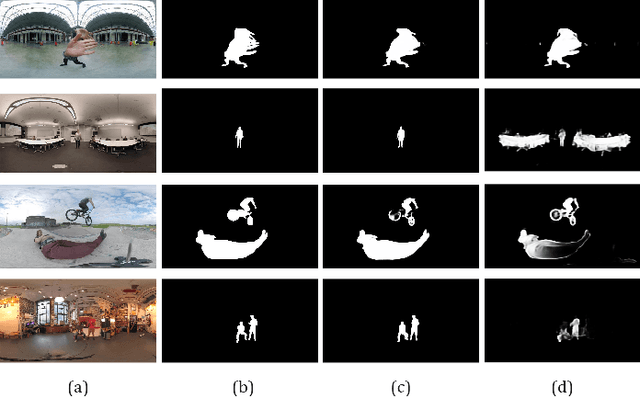
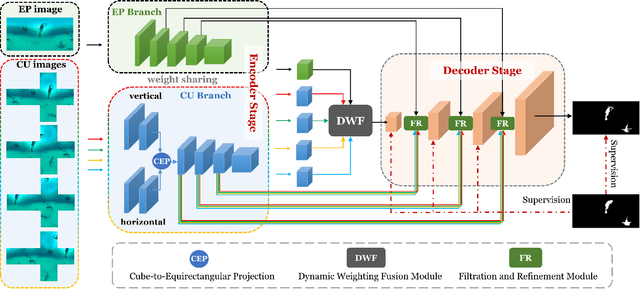
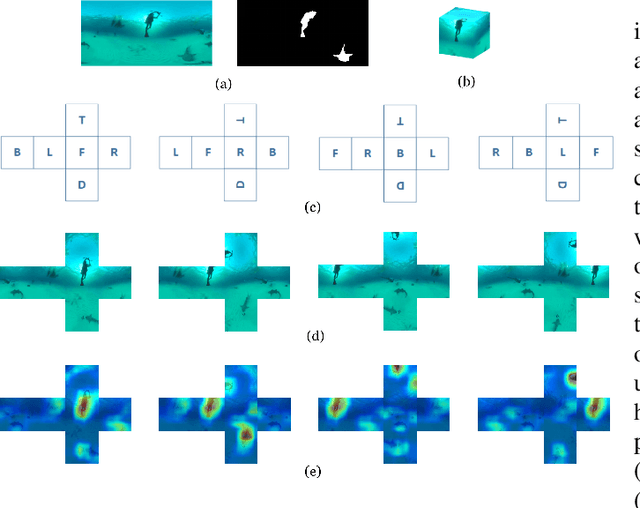
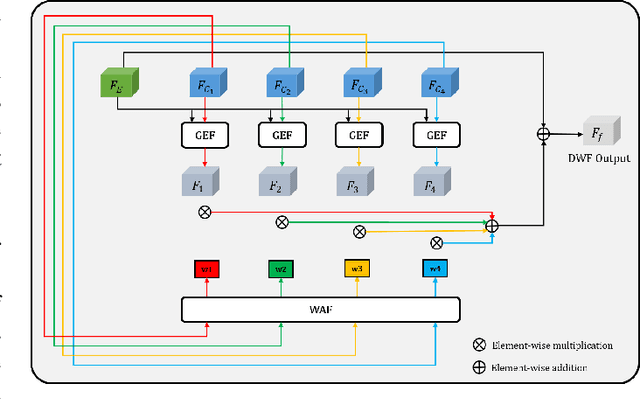
Abstract:Salient object detection (SOD) aims to determine the most visually attractive objects in an image. With the development of virtual reality technology, 360{\deg} omnidirectional image has been widely used, but the SOD task in 360{\deg} omnidirectional image is seldom studied due to its severe distortions and complex scenes. In this paper, we propose a Multi-Projection Fusion and Refinement Network (MPFR-Net) to detect the salient objects in 360{\deg} omnidirectional image. Different from the existing methods, the equirectangular projection image and four corresponding cube-unfolding images are embedded into the network simultaneously as inputs, where the cube-unfolding images not only provide supplementary information for equirectangular projection image, but also ensure the object integrity of the cube-map projection. In order to make full use of these two projection modes, a Dynamic Weighting Fusion (DWF) module is designed to adaptively integrate the features of different projections in a complementary and dynamic manner from the perspective of inter and intra features. Furthermore, in order to fully explore the way of interaction between encoder and decoder features, a Filtration and Refinement (FR) module is designed to suppress the redundant information between the feature itself and the feature. Experimental results on two omnidirectional datasets demonstrate that the proposed approach outperforms the state-of-the-art methods both qualitatively and quantitatively.
zPROBE: Zero Peek Robustness Checks for Federated Learning
Jun 24, 2022

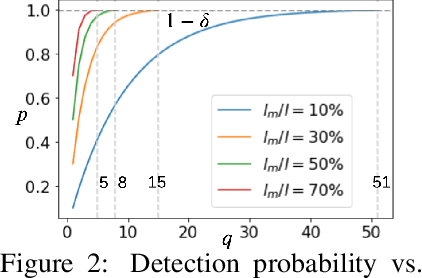

Abstract:Privacy-preserving federated learning allows multiple users to jointly train a model with coordination of a central server. The server only learns the final aggregation result, thereby preventing leakage of the users' (private) training data from the individual model updates. However, keeping the individual updates private allows malicious users to perform Byzantine attacks and degrade the model accuracy without being detected. Best existing defenses against Byzantine workers rely on robust rank-based statistics, e.g., the median, to find malicious updates. However, implementing privacy-preserving rank-based statistics is nontrivial and unscalable in the secure domain, as it requires sorting of all individual updates. We establish the first private robustness check that uses high break point rank-based statistics on aggregated model updates. By exploiting randomized clustering, we significantly improve the scalability of our defense without compromising privacy. We leverage the derived statistical bounds in zero-knowledge proofs to detect and remove malicious updates without revealing the private user updates. Our novel framework, zPROBE, enables Byzantine resilient and secure federated learning. Empirical evaluations demonstrate that zPROBE provides a low overhead solution to defend against state-of-the-art Byzantine attacks while preserving privacy.
AdaTest:Reinforcement Learning and Adaptive Sampling for On-chip Hardware Trojan Detection
Apr 12, 2022
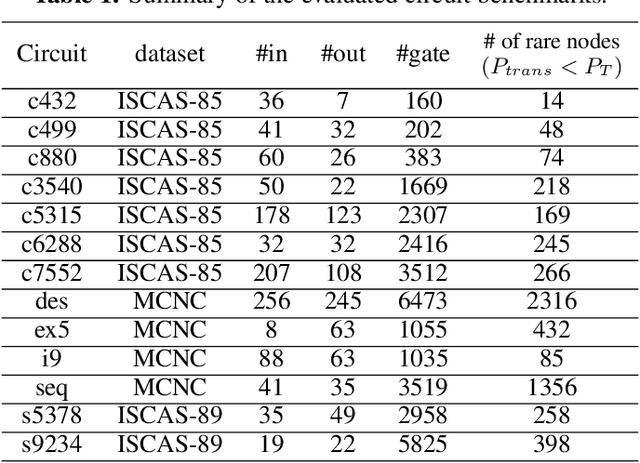
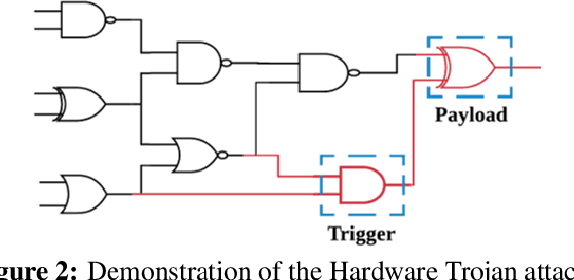
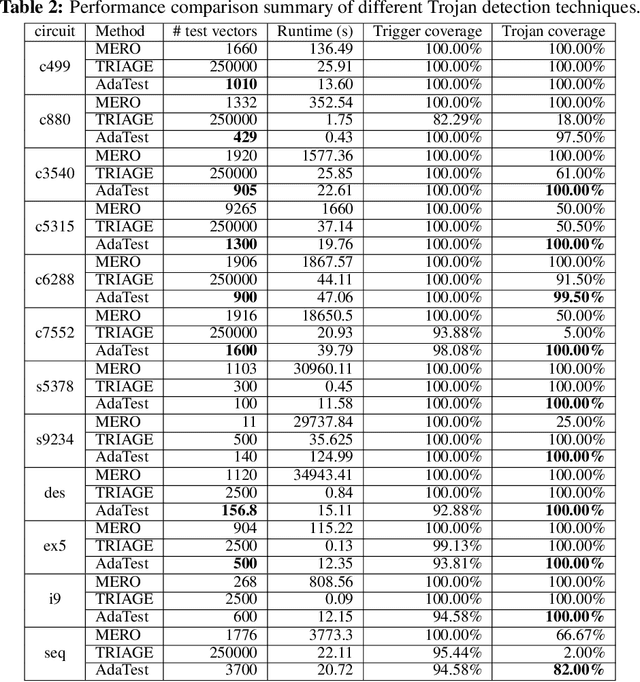
Abstract:This paper proposes AdaTest, a novel adaptive test pattern generation framework for efficient and reliable Hardware Trojan (HT) detection. HT is a backdoor attack that tampers with the design of victim integrated circuits (ICs). AdaTest improves the existing HT detection techniques in terms of scalability and accuracy of detecting smaller Trojans in the presence of noise and variations. To achieve high trigger coverage, AdaTest leverages Reinforcement Learning (RL) to produce a diverse set of test inputs. Particularly, we progressively generate test vectors with high reward values in an iterative manner. In each iteration, the test set is evaluated and adaptively expanded as needed. Furthermore, AdaTest integrates adaptive sampling to prioritize test samples that provide more information for HT detection, thus reducing the number of samples while improving the sample quality for faster exploration. We develop AdaTest with a Software/Hardware co-design principle and provide an optimized on-chip architecture solution. AdaTest's architecture minimizes the hardware overhead in two ways:(i) Deploying circuit emulation on programmable hardware to accelerate reward evaluation of the test input; (ii) Pipelining each computation stage in AdaTest by automatically constructing auxiliary circuit for test input generation, reward evaluation, and adaptive sampling. We evaluate AdaTest's performance on various HT benchmarks and compare it with two prior works that use logic testing for HT detection. Experimental results show that AdaTest engenders up to two orders of test generation speedup and two orders of test set size reduction compared to the prior works while achieving the same level or higher Trojan detection rate.
An Adaptive Black-box Backdoor Detection Method for Deep Neural Networks
Apr 08, 2022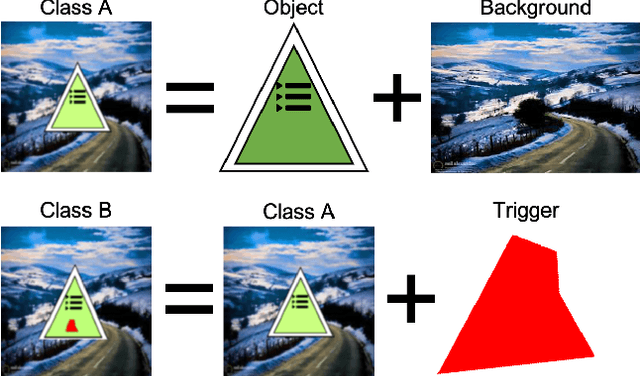
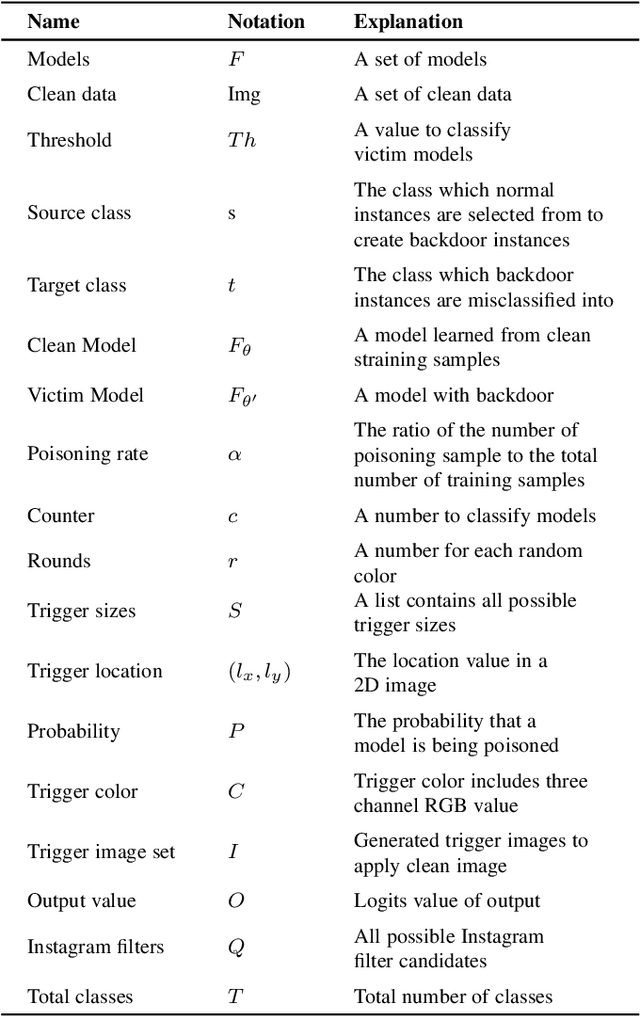
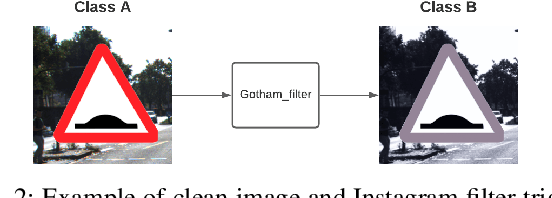
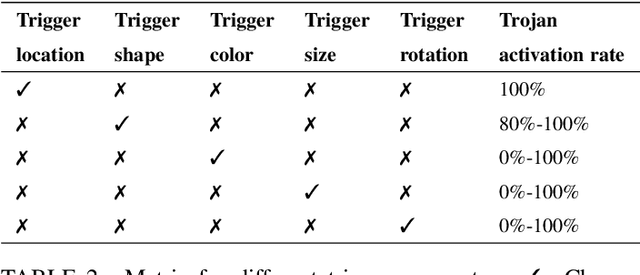
Abstract:With the surge of Machine Learning (ML), An emerging amount of intelligent applications have been developed. Deep Neural Networks (DNNs) have demonstrated unprecedented performance across various fields such as medical diagnosis and autonomous driving. While DNNs are widely employed in security-sensitive fields, they are identified to be vulnerable to Neural Trojan (NT) attacks that are controlled and activated by stealthy triggers. In this paper, we target to design a robust and adaptive Trojan detection scheme that inspects whether a pre-trained model has been Trojaned before its deployment. Prior works are oblivious of the intrinsic property of trigger distribution and try to reconstruct the trigger pattern using simple heuristics, i.e., stimulating the given model to incorrect outputs. As a result, their detection time and effectiveness are limited. We leverage the observation that the pixel trigger typically features spatial dependency and propose the first trigger approximation based black-box Trojan detection framework that enables a fast and scalable search of the trigger in the input space. Furthermore, our approach can also detect Trojans embedded in the feature space where certain filter transformations are used to activate the Trojan. We perform extensive experiments to investigate the performance of our approach across various datasets and ML models. Empirical results show that our approach achieves a ROC-AUC score of 0.93 on the public TrojAI dataset. Our code can be found at https://github.com/xinqiaozhang/adatrojan
FaceSigns: Semi-Fragile Neural Watermarks for Media Authentication and Countering Deepfakes
Apr 05, 2022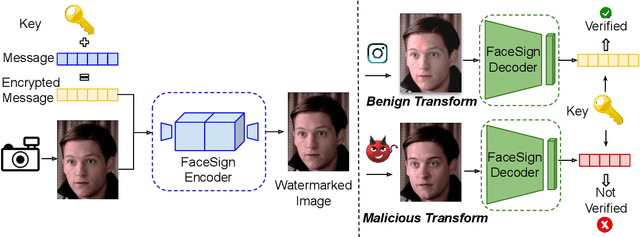
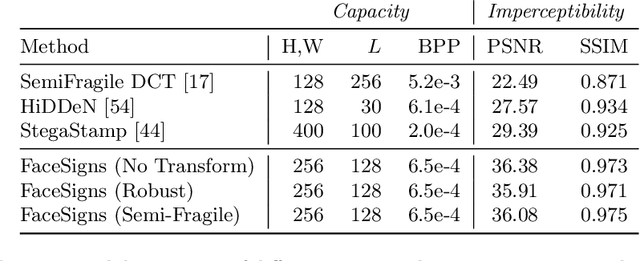
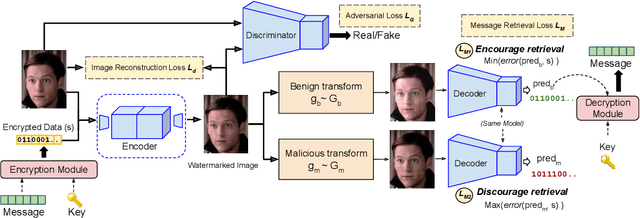

Abstract:Deepfakes and manipulated media are becoming a prominent threat due to the recent advances in realistic image and video synthesis techniques. There have been several attempts at combating Deepfakes using machine learning classifiers. However, such classifiers do not generalize well to black-box image synthesis techniques and have been shown to be vulnerable to adversarial examples. To address these challenges, we introduce a deep learning based semi-fragile watermarking technique that allows media authentication by verifying an invisible secret message embedded in the image pixels. Instead of identifying and detecting fake media using visual artifacts, we propose to proactively embed a semi-fragile watermark into a real image so that we can prove its authenticity when needed. Our watermarking framework is designed to be fragile to facial manipulations or tampering while being robust to benign image-processing operations such as image compression, scaling, saturation, contrast adjustments etc. This allows images shared over the internet to retain the verifiable watermark as long as face-swapping or any other Deepfake modification technique is not applied. We demonstrate that FaceSigns can embed a 128 bit secret as an imperceptible image watermark that can be recovered with a high bit recovery accuracy at several compression levels, while being non-recoverable when unseen Deepfake manipulations are applied. For a set of unseen benign and Deepfake manipulations studied in our work, FaceSigns can reliably detect manipulated content with an AUC score of 0.996 which is significantly higher than prior image watermarking and steganography techniques.
AgileNet: Lightweight Dictionary-based Few-shot Learning
May 21, 2018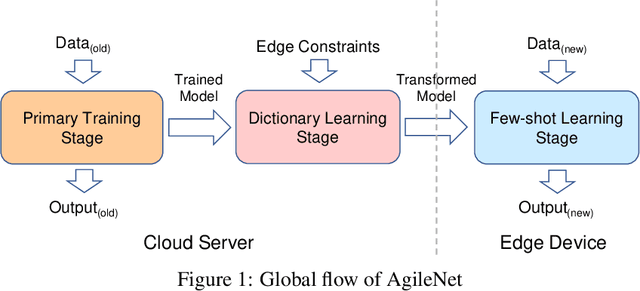
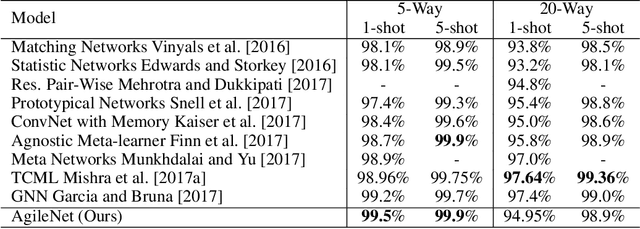
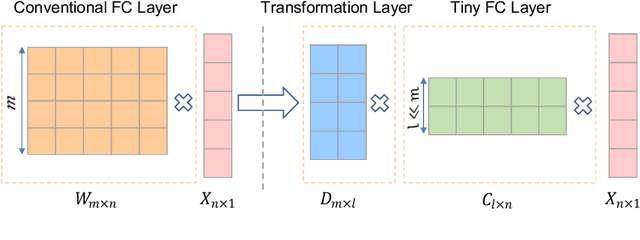
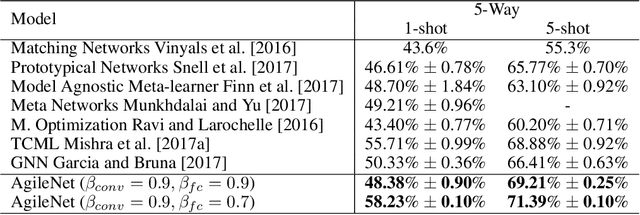
Abstract:The success of deep learning models is heavily tied to the use of massive amount of labeled data and excessively long training time. With the emergence of intelligent edge applications that use these models, the critical challenge is to obtain the same inference capability on a resource-constrained device while providing adaptability to cope with the dynamic changes in the data. We propose AgileNet, a novel lightweight dictionary-based few-shot learning methodology which provides reduced complexity deep neural network for efficient execution at the edge while enabling low-cost updates to capture the dynamics of the new data. Evaluations of state-of-the-art few-shot learning benchmarks demonstrate the superior accuracy of AgileNet compared to prior arts. Additionally, AgileNet is the first few-shot learning approach that prevents model updates by eliminating the knowledge obtained from the primary training. This property is ensured through the dictionaries learned by our novel end-to-end structured decomposition, which also reduces the memory footprint and computation complexity to match the edge device constraints.
 Add to Chrome
Add to Chrome Add to Firefox
Add to Firefox Add to Edge
Add to Edge